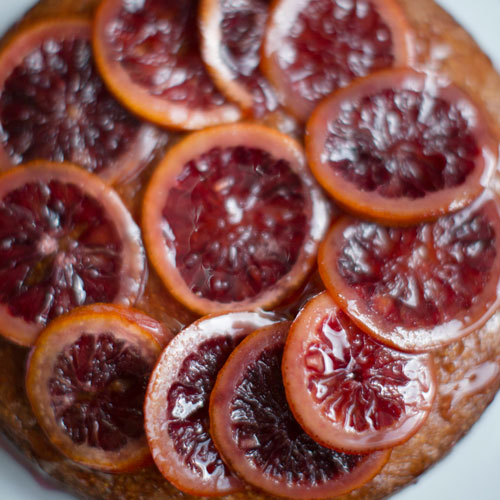Olive Oil Polenta Cake with Blood Oranges

As seen in Town & Country magazine!
This beautiful cake recipe has been shared all over the world. Make your own beautiful Olive Oil Polenta Cake with Blood Oranges to show off at your next dinner party.
Olive Oil Polenta Cake with Blood Oranges
Ingredients:
¾ c caster sugar
¼ c light muscovado sugar
3 eggs
½ cup olive oil
½ cup almond flour
1 cup Cup 4 Cup Gluten Free Multipurpose Flour or Doves Farm Free From Gluten Plain White Flour (If using Doves Farm blend, add 1 teaspoon of xanthan gum to the mixture)
¾ cup instant polenta
1 ½ teaspoon baking powder
½ teaspoon salt
zest of 2 blood oranges or regular oranges
4 tablespoon plain Greek yogurt or coconut yogurt
1 tablespoon honey
One 9” springform pan
For Syrup:
½ cup blood orange juice or freshly squeezed regular orange juice
½ cup sugar
Method:
Grease the spring form pan with olive oil and line bottom with a round of parchment paper cut to fit the pan. Dust lined pan with a bit of polenta and set aside.
Preheat oven to 175° C (350° F).
In the bowl of an electric mixer fitted with the whisk attachment, beat the eggs and sugar on medium speed until they are fluffy, pale in color, and nearly tripled in volume. About 3-5 minutes.
While the eggs are beating, in a separate bowl mix together the dry ingredients. Combine the almond flour, polenta, 1 cup GF Flour blend (plus xanthan gum if using), baking powder, and salt.
In another bowl or liquid measuring cup, stir together the olive oil, yogurt, and honey.
Turn the mixer onto low, and starting with one third of the dry ingredients, alternate adding the dry and wet ingredients to the egg mixture in 3 additions. Mix just to combine as you don’t want to lose all the lovely, airy lightness and volume you have just beaten into the eggs and sugar.
After the last third of the olive oil has been mixed into the batter, turn the mixer off and add in the orange zest. Using a rubber spatula, gently stir to fully incorporate, scraping the bottom to make sure everything is homogenized.
Using the spatula, scrape the batter into the prepared pan and smooth the top. Jiggle the pan a bit, to make sure everything is level and evenly dispersed and give it a little rap on the counter to get rid of any air bubbles.
Place the cake in the center rack of your preheated oven and bake for 35-40 minutes, or until the edges of the cake start to pull away from the edges of the pan and a toothpick or cake tester comes out clean.
Let the cake cool in the pan on top of a wire rack while you make the syrup.
For the syrup:
Combine the sugar and orange juice in a small saucepan over medium low heat until the sugar is fully dissolved.
Using a cake tester or toothpick, gently prick the top of the cake. Pour the warm syrup over the top of the cake and leave to cool in the pan.
Candied blood oranges:
If possible, only use oranges with thinner skins and a thin layer of pith as you will be eating all of it and even when candied, thick orange rind can be very chewy. Thinner slices of oranges and thinner layers of pith are much easier to cut when on top of the cake. As the amount of pith can vary a lot between oranges and is impossible to tell before slicing, I generally slice 3-4 oranges and use the slices from those with the least amount of pith and the juice from the extra one or two.
1 cup water
1 cup sugar
2-3 blood oranges, thinly sliced with end slices discarded.
Method:
In a large heavy bottomed skillet with lid or pan like a Le Creuset, add water and sugar.
Arrange the blood orange (or regular orange) slices in a single layer in the pan and bring mixture to a boil.
Once the mixture is boiling and sugar is fully dissolved, reduce heat to medium low and simmer for one hour, or until the pith of the orange becomes translucent and soft
Allow the oranges to cool in the pan until they reach room temperature
Candied blood oranges can be made ahead and stored in their syrup in the refrigerator until ready to serve, then warmed to room temperature.
To serve:
Remove the cooled cake from the pan, peeling the parchment from the bottom. Place cake atop cake plate or cake stand
Gently arrange the candied blood orange slices atop the cake. I like to pick the prettiesr one to place in the center and then layer the rest in overlapping concentric circles around it. Perfect or not, the gorgeous red hue, glossy with syrup looks amazing atop ther cake
Once the cake is covered with the orange slices, spoon any remaing syrup on top to give an even glossier finish, allowing a bit of the syrup to drizzle down the sides
